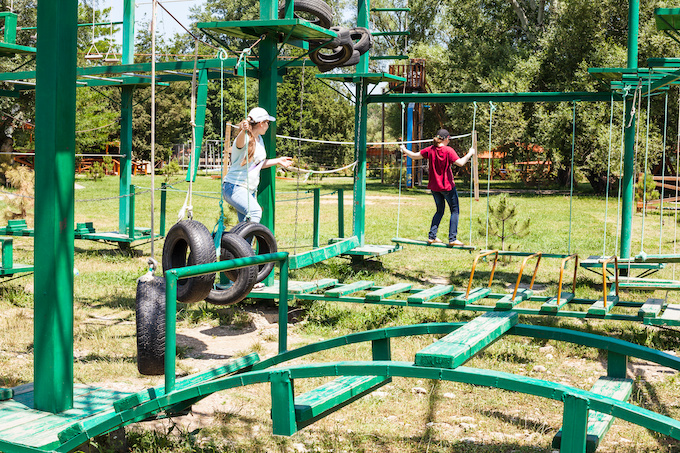
Written By Stephen Lowe
In my last post I wrote about game-based learning and differentiated it from gamification. In this article I look at the gamification of online courses.
I suggest that gamification is not only about points, leaderboards, and badges. It may simply be about the language we use, and our approach. However the learning experience designer chooses to go about it, I assert that it will always have three dimensions: harder, faster, and levelling up.
Gamification of online learning is a serious business. Let’s start by making a collaborative document and setting out a table of goals and actions. Let’s wrap some theory around this, and pull together a cross-disciplinary team. Yeah, right. Or let’s sit on the floor, behave like kids, think like Māui the Trickster, and have some fun with it. Which do you think will work best? Are you on for this? Press START.
Harder
Sure, you want to make it easy to get started, but soon after that you want to get busy putting artificial obstacles in the way. Not too many. You have to get just the right balance between difficulty and progress. If you ever played Machinarium (insert any dungeon crawl you did play) you will know that the thing that kept you coming back was that it was insanely hard to find your way out of one room and into the next.
Everyone likes to quiz
Quizzes, puzzles, and challenges are a great way to structure the content. You don’t necessarily even have to lay the content out first, rather you just embed it in the quiz. Or flip the usual layout: put the quiz first and put the content second, served up like a resource to be trawled for facts if required. Crafting Socratic questions into the feedback fields of a multi-choice will lead the learner to the right answer. Give them multiple attempts, encourage guessing, require a high passmark like 90% or even 100%. Moodle and H5P (and many other platforms) offer the learning designer different flavours of multi-choice, no longer are you stuck with radio buttons and checkboxes.
Demand submissions to unlock the levels
There’s a good learning model that lends itself well to gamified online learning: aggregate, remix, repurpose, feed forward (Cormier). Require your learners to collect new knowledge, synthesise it into something of their own, apply it to a problem, and submit it for examination by the Old Wizard to allow them passage to the next level. No passkey, no access. Learners of all ages understand and acknowledge this motif; that is why Rowling and Tolkien are such popular authors.
Instant feedback
For every hard thing there must be immediate recognition and reward for achievement. For every failure there must be a penalty, an instant fine. Forget higher-order learning strategies, this is pure behaviourism. That is not to say that learning strategies that work with the intrinsic motivation of the player-learner cannot be deployed inside each discrete activity. But progress through the learning landscape is old-school carrot and stick. It’s all about framing, you have to make receiving the penalty part of the fun. Drop and give me fifty, soldier. If that doesn’t sit well with you, then maybe this is time to go for a long walk and ask yourself The Big Question: Is gamification for me?
Well-crafted games are an artful blend of intrinsic pleasure and extrinsic scaffolding. – Amy Jo Kim
Faster
If computers sap your energy, they also eat time. When someone says to me ”online learning”, I see a pool of light from an angle poise light. The clock says one a.m. and everyone in the house has gone to bed except me. But you can do more with a clock than stare at it. You can use it as a powerful motivator. Just as a fitness freak says I wonder if I can run 10 kilometres in an hour, so a learner releases endorphins by saying I wonder if I can complete this quiz in under five minutes for 500 bonus XP. It’s a balance of anxiety against boredom. Yes, your river runs deep, but it flows swiftly too.
Far-off deadlines kill online learning
Like Christopher Columbus, online learners need rhythm for a compass. A strict weekly beat marked out by the Metro Gnome is what makes eLearning go. Practice it in the mirror: “I need you to do the reading, score 100% in the quiz, and submit the assignment by this time next week.” Depending on your context you might even want to substitute ‘day’ for ‘week’. Oh, and some points, tokens, awards, and a place on the leaderboard will really help to make this happen. It won’t work for everybody. You’ll need a rescue truck. Tick the boxes that enable multiple attempts and late submissions.
Treasure hunts are fun
Put those potentially isolated individual learners into teams. Give those teams fun names like ‘The Tigers’. Put up a prize like 1000 XP for the winning team and 250 XP for entering. Now, set the Challenge. Imagine you can contrive for each individual to find a nugget of learning, carry it to some forum or wiki where the first team to assemble all the nuggets into a golden chalice wins. I’m being metaphorical here, I’m not suggesting you have to be a world-class animator. What I am saying is that dividing the learning, running with it along some pathway, collecting it into one place, and combining it into an exhibit is a powerful model. This kind of thing will get the majority of the learners through into the next Level. I’m assuming you’re either a teacher or a learning designer, so you no doubt have a rich repertoire of creative ideas you can bring to dry old online learning.
Nano-learning builds skills
Provide resources that learners can do in the interstitial spaces in their life: waiting for mum, stuck in traffic, medical centre waiting room. Flip cards are a good example. If you get 25 XP every time you run through them, why would you not run through them 4 times? Drag and drop, same story. Barbara Oakley emphasises retrieval practice. She says it’s easy to kid yourself you’re learning when all you’re really doing is repetition. Try breaking this cycle by creating a five-question quiz of the text box type where the learner must actually type five remembered words, correctly spelt, to gain the XP. Repeat the quiz on each level, but progressively reduce the time in which it must be done. Now the learner is tapping right into their neural networks, retrieving, and articulating. Harder. Better.
Level Up
In games, we are the protagonist—the person with agency, facing a series of choices and challenges along our journey towards mastery. – Amy Jo Kim
The reason progression through Modules 1, 2, 3, and 4 can get boring is that there’s no sense of getting stronger to face greater challenges. Too often it’s just more of the same, resulting in attrition from about mid-course on. In games your character gains knowledge, skills, tools, and powers in each Level to prepare them for the challenges that lie ahead. Online learning is sometimes doing that, but it’s not worn on the sleeve like it is in games.
Mind your language
Gamification of online learning could be achieved simply by the language we use. For example, “Be sure you know the twenty terms in the glossary by heart because you are going to need this knowledge to complete the challenges in the next Module. There is a twenty-question quiz on the terms in the glossary, you must get 90% to unlock the next Module.”
Nudge, tempt, shove
Gamification of online learning may be no more than using some well-crafted well-placed nudges. We are herd animals. Some will be happy to be the stragglers at the back, but they won’t want to be left out altogether. Try announcing “half the class have now moved to the next Module”. The principles of universal design for learning apply to gamified courses just the same, so you want to offer multiple pathways to unlock the next Level. However, if one of these pathways has a track-record of success you may want to make it the default pathway, or sign-post it as ‘recommended’, or simply call it the Yellow Brick Road.
Provide real time support
Pretend you’re Florence Nightingale and create a cool chart. It might show how half the learners drop out when they fail the first level-up quiz. Watch the activity logs or if you’re geek-gurl set them up to notify you. Get in there at fail time with consolation prizes and words of encouragement. Throw XP around like confetti (after all, it’s virtual and it doesn’t cost a cent). Do not do what so many online teachers do, and abandon them in their hour of need. Richard Bartle, in his wonderful book Designing Virtual Worlds, calls this the Live Team. You are the live team.
It’s a wrap
There are a lot of products on the market. I am assuming, reflected in the title to this piece, that you are not in the market for those. Moodle continues to be one of the most powerful free environments for online learning. Each release it gets better and better. Now you can record video and audio directly into a forum post. How good is that? This is where the individual learners could bring their nuggets of new-found knowledge to assemble them into that golden chalice.
As a teacher you must design it. You must create situations that demand sharing. – Jesse Schell
If you’re a teacher you may like to approach it from first principles and know why you’re doing it before you address the how. Like me, you may have to approach this in a creative way and hack your way to success on a shoestring. Good luck, and follow the code: harder, faster, level up!
By the way, did you uncover the Old Pirate Pass Phrase hidden in the text? Clue: “Let no word go unturned until you have the key. Hover your mouse my hearties only then I’ll set ye free. For where you see gold, there treasure be!” Email the pass phrase to [email protected] to claim your share of the treasure!
Suggested resources
- Jesse Schell, Learning is beautiful. YouTube Video (23 mins)
- Amy Jo Kim. Game Thinking: Innovate smarter & drive deep engagement with design techniques from hit games. (Available from Amazon)
- Richard Bartle. Designing Virtual Worlds 1st Edition. (Available from Amazon)
- Ploy Buraparate. Dungeons & Dragons & Design Thinking on the UX Collective Blog.
- Moodle plugins Level Up.









